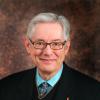KANSAS CITY, MO. -- Shane Schaetzel keeps close tabs on American and Canadian Anglicans who want to become Catholic in a new way.
They hope to become part of the Anglican “personal ordinariate” once it’s created. Joining it will make them members of the Catholic church but let them keep the Anglican liturgy and patrimony, or collection of ecclesial practices.
“It’s really hard to put a number on it,” said Schaetzel, 40, a respiratory therapist in Springfield, Mo., “but if it were to be started today it would be much larger than the ordinariate in the U.K.” That ordinariate welcomed nearly 1,000 people as its first members last month. (See related story.)
Americans wanting to join are asked to express official interest via a letter to Cardinal Donald W. Wuerl, the Catholic archbishop of Washington. Then Wuerl, working with his secretary, Fr. Scott Hurd, will help determine the future of the ordinariate in America.
More than 10 years ago Schaetzel abandoned his idea of becoming a priest in the Episcopal church, to which he then belonged. Instead, he joined the Catholic church and hoped to become part of an Anglican use congregation, but none was available. So last year Schaetzel and a dozen others in Springfield created the St. Augustine of Canterbury Society Anglican use prayer group, and he has been named its lay officiant. As a Catholic, he’s ineligible to join the new ordinariate, but could worship with a congregation within it.
Schaetzel’s attraction to the Anglican liturgy, based largely on the 1928 prayer book, is similar to what has moved Episcopalians James and Carol Patton of suburban Kansas City to find an Anglican use congregation and prepare to join the new ordinariate.
The Episcopal church, James Patton says, has “drifted away” from its traditional liturgy: “The Episcopal church always said it stands on the three-legged stool of reason, tradition and scripture. I’m not comfortable with the Episcopal church on any of those three positions, but they have utterly abandoned tradition.” (“And scripture,” Carol Patton adds.)
The Pattons still are members of St. James Episcopal Church in Dexter, Mich., from which they moved last fall, but are to be received into an Anglican use group at St. Therese Little Flower Catholic Church of Kansas City, Mo., on Pentecost, June 12.
Wuerl -- who is to report on the ordinate at the mid-June meeting of the U.S. bishops’ conference -- declined a request to reveal how many people, parishes or clergy have sent letters of intent to join the ordinariate, but future ordinariate members are coming from several sources.
“I have close to 75 clergymen -- bishops, priests, deacons in the Anglican Church in America [of the Traditional Anglican Communion] -- in my capacity as bishop in charge of the Patrimony of the Primate who are seeking to be ordained Catholic priests for the Personal Ordinariate,” says Bishop David Moyer of the Traditional Anglican Communion. “They are coming from all over the U.S., but the heaviest concentration is in the Midwest, the Middle Atlantic States and the South.”
Anglicans are not alone in expressing interest in the ordinariate. Catholics such as Schaetzel are, too, though the guidelines now prevent them from becoming official members.
Another such Catholic is Brent Stull, a graduate music student at the University of Kansas in Lawrence. Stull, born and reared a Catholic, says, “I believe the ordinariate will foster a new appreciation for, and devotion to, the true aspects of Roman Catholic worship. Much of the Anglican patrimony that will be used in the ordinariate, and is mentioned in Anglicanorum coetibus, is actually Roman Catholic in origin. Anglicans preserved practically all of the customs and liturgical practices predating their excommunication from the Holy See. Consequently, when Pope Paul VI promulgated the Second Vatican Council and much of our history and tradition were lost, the Anglican church, again, faithfully preserved the customs and liturgical practices of a more ancient time.”
Another traditionalist Catholic says, “My interest in the ordinariate is generally liturgical, linguistic and musical.” She’s a Midwesterner who asked not to be named but whose faith journey has led her to the Catholic church after being a member of Disciples of Christ, Baptist and Unitarian-Universalist congregations. “The [Anglican use] liturgy seems to be very ‘high church’ -- processions, grand hymns played only on the organ, frequent incense, ornate vestments, prayers and a scripture translation in beautiful English.”
Many traditionalist Anglicans and Catholics view the new ordinariate less as a way for disaffected Anglicans to find a spiritual home than as a move toward Christian unity. As Catholic Online reported recently, “William Johnstone, a former Anglican priest who now works with the St. Barnabas Society, wrote in The Catholic Herald U.K. about the great wound for the two churches as well as potential healing that began in the embers of ARCIC [the Anglican-Roman Catholic International Commission, established in 1967] and could come fully aflame in the Anglican ordinariate.”
For now, Schaetzel and others wait: “Now I’m a lay officiant ... for the evening prayer office, and that’s all I can do right now [without a priest].” But one day he hopes thousands of North Americans will, through the ordinariate, join him as Catholics, though there are strong indications that an ordinariate for Americans may move forward more quickly than for Canadians.
[Bill Tammeus, a Presbyterian elder and award-winning former Faith columnist for The Kansas City Star, writes the column “A small c catholic”.]
More resources:
Shane Schaetzel’s Google Map of “Emerging Anglican Catholic Ordinariates”
tinyurl.com/3hestxb
Anglican Patrimony
anglicanpatrimony.blogspot.com
Ordinariate Portal
ordinariateportal.wordpress.com
The Anglo-Catholic
www.theanglocatholic.com




